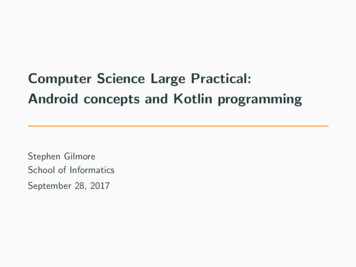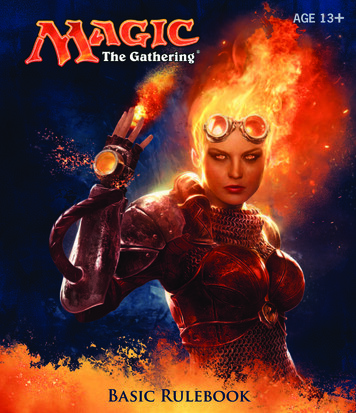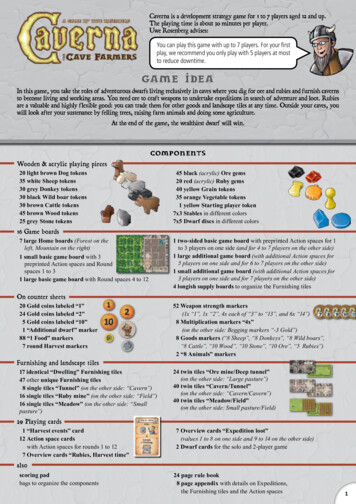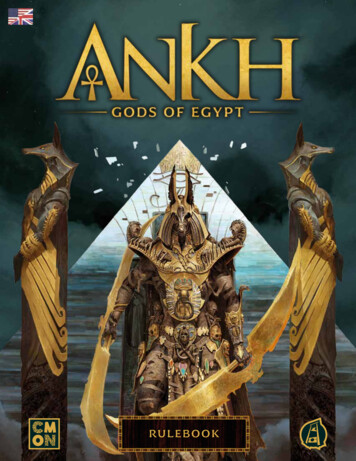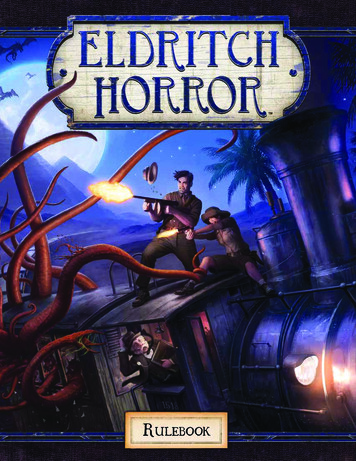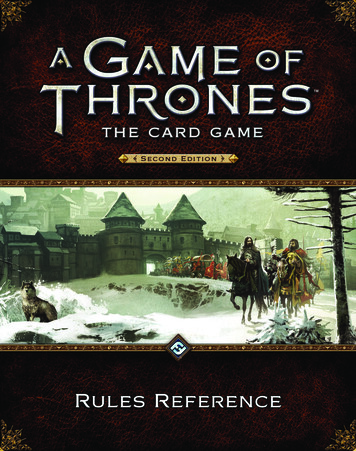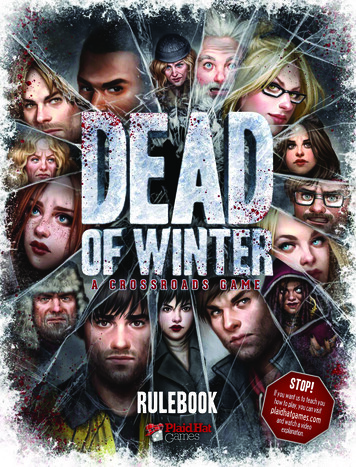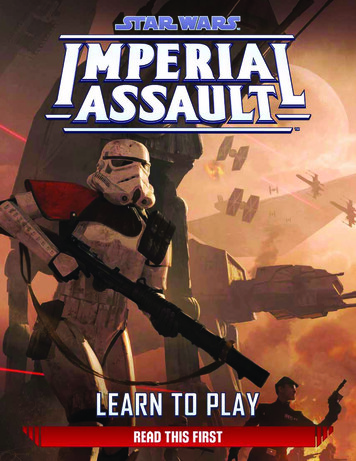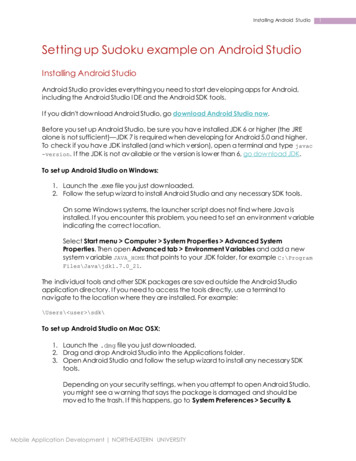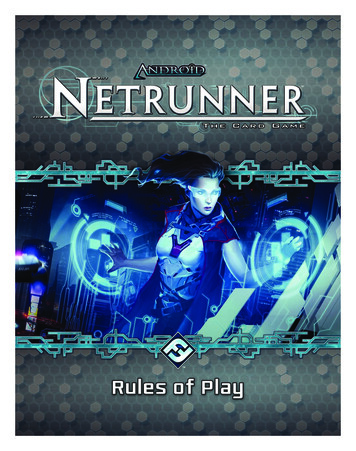
Transcription
1
TMTMOver the course of 18 hours, the runners hit Jinteki, Haas-Bioroid,and Weyland Consortium with DOS attacks, datatheft, and atruly vulgar piece of cyber-vandalism. These attacks cost eachmegacorp millions upon millions of credits. NBN put togethera holo-report inside half an hour. Thirty minutes after the thirdmegacorp node went dark, Lily Lockwell was standing in frontof the Beanstalk gravely lecturing on the evils of unregulatednetworks and the rise of cybercrime worldwide. Five minuteslater, the runners had struck again; now Lockwell was readingout the Anarch’s Manifesto. They hadn’t bothered to make her lipssynch with the new audio track. One in three feeds got a specialbonus: Lockwell’s head grafted onto a sense-star’s scantily-cladbody.The talking heads said it was a legion of organizedcybercriminals, Tri-Maf activity, Martian terrorists. They werewrong. It was three people–a g-mod from Heinlein, a cyborg NewAngelino, and a baseline woman from BosWash–who knew oneanother by reputation only. But the heads were right about onething: it was the start of a cyber war, one that neither side couldafford to lose.The Living Card GameAndroid: Netrunner is a two-player game that can beplayed using only the contents of this box, knownas the core set. However, Android: Netrunner is alsoa Living Card Game (LCG ) that evolves over timewith regularly released expansions. Each expansionoffers players many additional cards that add variety,new customization options, and rich themes to thegame. Unlike most collectible card games, all LCGexpansions have a fixed distribution–there is norandomization to their contents.2IntroductionWelcome to Android: Netrunner. It is the future. Humanity hasspread itself across the solar system with varying degrees ofsuccess. The Moon and Mars are colonized. A plan to terraformthe Red Planet is well underway, hindered only by a civil warthat has broken out and locked down many of its habitationdomes. On Earth, a massive space elevator has been builtnear the equator in the sprawling megapolis of New Angeles,stretching up into low orbit. It is the hub of trade in the solarsystem, and most people refer to it as the “Beanstalk.”Computers have continued to advance along with discoveriesin the field of neurobiology. This has led to brain-mapping, amethod by which a human mind can be stored electronicallyin sophisticated mind-machine interface devices. The physicalmouse and keyboard are archaic relics; gestural interfaces andvirt displays are commonplace. Elite users “jack in,” pluggingthe computer directly into their brains.Enormous megacorporations, called corps by most, influenceevery facet of daily life: food, threedee, music, career choices.Jinteki and Haas-Bioroid redefine life itself, making clones andbioroids with braintaped, artificially-intelligent minds. TheWeyland Consortium owns a piece of everything that goes upor down the Beanstalk, and everything goes up or down theBeanstalk. And NBN shapes what you think and dream, withthe most extensive media network ever conceived on Earthunder their control.Everyone relies on the network, the all-seeing, all-hearing gridthat surrounds Earth and reaches out into the solar systembeyond. More data flows through the network every secondthan was ever expressed in the first five thousand years ofwritten language. It is a surveillance network, a financialsystem, a library–it is the backbone of modern civilization. Andit is also the only weakness the corps have.The network is forever evolving and moving, impossibleto completely pinpoint or lock down. Rogue operators–computer specialists with the hardware, software, and rawtalent to challenge the system–use the sprawl of the net totheir advantage. Some want to expose the rot that lies at theheart of the system, and to awaken the teeming billions to thehypocrisy of their corporate masters. Others just want to earn aprofit, or express themselves in the ultimate medium. Whatevertheir motivation, the actions of these individuals intersect in acommon cause: that of digital independence. They are runners.
Game OverviewCorporate FactionsAndroid: Netrunner is a card game for two players set in thedystopian future of the Android universe. One player assumesthe role of a Runner, a rogue hacker armed with bleeding-edgegear and software, while the other player controls a powerfulCorporation that will stop at nothing to achieve its goals.In Android: Netrunner there are four different Corporatefactions to choose from. Corporate factions are important fordeckbuilding (see “Deckbuilding” on page 24) and eachCorporate faction has certain cards affiliated with it. Thesefactions are:In Android: Netrunner, players alternate taking turns, beginningwith the Corporation. During the Corporation’s turn, he hasthree clicks to spend. The Corporation can spend his clicks toperform a variety of actions, including gaining credits, drawingcards, installing cards, and advancing agendas. The Corporationmust carefully divide his efforts between defensive actions, suchas protecting his servers from the Runner, and offensive actions,such as tracing the Runner or advancing agendas.The Runner has four clicks to spend during his turn. TheRunner can also spend his clicks to perform a variety of actions,including gaining credits, drawing cards, installing cards, andmaking runs. During a run, the Runner attempts to hack intothe Corporation’s servers in an effort to hinder the Corporationand steal his agendas. The Runner has several different targetsto choose from when initiating a run; choosing where andwhen to run is a key part of an effective Runner strategy.Object of the GameThe objective for both players is to score seven agenda points.The Corporation scores agenda points by advancing agendas;the Runner scores agenda points by stealing agendas fromthe Corporation. Agendas are cards that only appear in theCorporation’s deck.The Corporation also wins if the Runner is flatlined (see“Damage” on page 20) and the Runner wins if the Corporationmust draw a card from his empty draw deck.AstroScript Pilot ProgramAn agenda cardworth 2 agendapoints.Place 1 agenda counter on AstroScriptPilot Program when you score it.Hosted agenda counter: Place1 advancement token on a card that can beadvanced. 2012 Wizards of the Coast LLC. FFGIllus. Matthew ZeilingerAGENDA: Initiative81JintekiNBNWeyland ConsortiumRunner FactionsIn Android: Netrunner there are three different Runner factionsto choose from. Factions are important for deckbuilding andeach Runner faction has certain cards affiliated with it. Thesefactions are:Anarch32Haas-BioroidCriminalShaperNeutral CardsSome Corporation and Runner cards have no faction affiliation.These cards are called neutral cards and can be used in anydeck of the corresponding side.3
Component OverviewOne-Credit \\Advancement Token (51)The Android: Netrunner core set includes the followingcomponents:One side of this token represents one credit. Creditsare the basic currency of Android: Netrunner.One creditCorporation Cards (134) 28 Haas-Bioroid CardsPosted BountyThe other side of this token is an advancement token.The Corporation uses advancement tokens to trackthe advancement of his installed cards.Advancement3Neural EMP2 28 Jinteki CardsOps 28 NBN CardsDavisOPERATION: GrayPlay only if the Runnermade a run duringAGENDA: Securityhis or her last turn.you mayPosted1 netBounty,damage.When you score DoRunner 1 tag and takeThe trick isn’t hittingforfeit it to give thethe person1 bad publicity. It’s hitting only the person you you were aiming at.Illus. Christina1Illus. Mauricio Herrera 28 Weyland Consortium CardsThe were aiming at.picks it up, even better.“Some two-cred newsyalleys of Guayaquil or the slumsscum could be in theoff-planet.”of BosWash. Not to mention 2012 Wizards of the Coast 2012 Wizards95LLC. FFG of the Coast LLC. FFGFive-Credit Token (8)72 22 Neutral Corporation CardsRunner Cards (114) 33 Anarch Cards 33 Criminal Cards 33 Shaper CardsThis token represents five credits.111DecoyBrain Damage Token (6)Illus. SandaraWyrmonPROGRCE: ConnectiAM:RESOURThis token represents one brain damage. TheRunner can get brain damage through various cardeffects.TangIcebreaker - AItag.]: Avoid receiving 13 : Break ice subroutine ona piece of icewithplace,strengt0 or lessthe wrongthis ish.“I get the feeling that1 : Ice has –1 strengtFrank.”h.that, D?”“What makes you say 1 : 1strength.curlers.”“TheFire and ichor.Illus. Mauricio Hererra 2012 Wizards of the Coast1 2012 Wizards of theLLC. FFGCoast LLC. FFG3213[: Install anagenda, asseupgrade ort,piece of ice.[: Playpiece[: Install a program,an ofoperation.hardware, or resource.[, 1 : Advance a card.[, [, [:[: Play an event.Purge viruscounters.tag.[, 2 : Remove[,12 : Trash1 resource if theRunner istagged.[: Make a run.[: Gain 1 .Click Tracker Tokens (2)& Cards (2)Together these are used to track howmany clicks a player has left to spendduring his turn. The reference cardwith four spaces is the Runner’s.The reference card with three is theCorporation’s.4 FFGof the Coast LLC.These cards show the actions a playercan perform during his turn.Corp ActioRunner Actionsns[: Dra[: Draw 1 card from yourw 1 card from R&D.[: Gain 1 stack. 2012 WizardsReference Cards (2) 2012 Wizards of the Coast LLC. FFG 15 Neutral Runner CardsBad Publicity \\Tag Token (12)One side of this token represents one point of badpublicity. The Corporation can get bad publicity Bad publicitythrough various card effects.The other side of this token represents one tag.The Runner can get tags through various cardeffects.Generic Tokens (23) 2012 Wizards of the Coast LLC. FFG 2012 Wizards of the Coast LLC. FFGOne side of this token is purple, and the other sideis red. Players use these tokens to track counters oncards as necessary. The most common counters areagenda counters, power counters, and virus counters.Tag
SetupTo prepare a game of Android: Netrunner, carefully follow thesteps below.1. Choose Sides: The players decide who will play as theRunner and who will play as the Corporation. Then, eachplayer places his identity card faceup in his play area andtakes a corresponding deck.Note: New players should use the Shaper and Jinteki starterdecks for their first game.2. Create Token Bank: Gather the credits, advancement, braindamage, tag, bad publicity, and generic tokens into piles.Keep these piles within reach of both players.3. Collect Starting Credits: Each player takes five credits fromthe bank.4. Shuffle Decks: Each player shuffles his deck. After shuffling,each player offers his deck to his opponent for furthershuffling.5. Draw Starting Hands: Each player draws five cards fromthe top of his deck to form his starting hand. After drawingstarting hands, the Corporation may choose to take amulligan by shuffling his hand back into his deck andthen drawing a new starting hand. After the Corporationdecides whether to mulligan, the Runner decides whether tomulligan as well. If a player takes a mulligan, he must keephis second hand as his starting hand. When the players aresatisfied with their starting hands, each player places his deckfacedown in his play area.Starter DecksThe game can be enjoyed straight out of the box bybuilding starter decks to play with.To make a starter deck, take all the cards of a singleCorporate or Runner faction and shuffle in all of theneutral cards for the chosen side. Starter decks arequick to build and are legal for tournament play.Below are the card numbers for the Corporatefactions, Runner factions, and Neutral cards thatappear in the core set:Corporation:Haas-Bioroid Cards #54-66Jinteki Cards #67-79NBN Cards #80-92Weyland Cards #93-105Neutral Cards #106-113Runner:This symbol identifies cardsincluded in the core set.Every card in the core sethas this symbol next to itscard number.Anarch Cards #1-16Criminal Cards #17-32Shaper Cards #33-48Neutral Cards #49-53These boxes represent thequantity of a card in thecore set and appear to theleft of the core set symbol.The Golden RuleIf the text of a card directly conflicts with the rulesin this book, the card text takes precedence.Important VocabularyPlayers should become familiar with the following terms beforereading the rest of the rules. Refer to the “Glossary” on page 30to look up other terms as needed.Active: An active card’s abilities affect the game and can betriggered.Inactive: An inactive card’s abilities do not affect the gameand cannot be triggered.Install: This is the game term for playing a card onto thetable.Credit: This is the basic unit of wealth, represented by .Click: This is the basic unit of work, represented by [.Rez: This is the act of flipping a facedown card faceup. TheCorporation installs his cards facedown and must rez them inorder to use them.5
Play AreasIn Android: Netrunner, the play areas for the Corporation andthe Runner differ significantly from one another. However, bothplayers have a credit pool, identity card, score area, and clicktracker.Credit PoolEach player has a credit pool where he keeps the credit tokenshe has available to spend. Spent credits are returned to thetoken bank.Identity CardEach player has an identity card that is placed faceup in his playarea. The identity card does not count toward his maximumhand or deck size, and is always active during the game.Score AreaEach player has a score area that holds his scored or stolenagendas. Agendas in a score area add their agenda points to aplayer’s score.Click TrackerEach player has a click tracker that he uses to track the numberof clicks left that he has to spend on his turn. This is a game aidonly and its use is optional.Corporation Play AreaIn addition to his credit pool, identity card, score area, and clicktracker, the Corporation’s play area includes his servers andhis ice. There are two types of servers: central servers andremote servers.Central ServersThe Corporation has three central servers: Headquarters,Research and Development, and Archives. Each centralserver also has a root.Headquarters (HQ)- This is the Corporation’s hand ofcards. Cards in HQ are inactive. The Corporation begins thegame with a maximum hand size of five cards. The Corporationidentity card represents HQ for the purposes of cardinstallation.Research and Development (R&D)-This is the Corporation’s draw deck. R&D is kept facedownwithin reach of the Corporation. Cards in R&D are inactive.Archives- This is the Corporation’s trash pile. Archives iskept adjacent to R&D. This is where Corporation cards areplaced when they are trashed or discarded. Cards inArchives are inactive.Runner Play AreaIn addition to his credit pool, identity card, score area, and clicktracker, the Runner’s play area includes his grip, his stack, hisheap, and his rig.GripThis is the Runner’s hand of cards. The Runner begins the gamewith a maximum hand size of five cards. Cards in the grip areinactive.StackThis is the Runner’s draw deck. The stack is kept facedownwithin reach of the Runner. Cards in the stack are inactive.6Some cards enter Archives faceup, and some cards enterArchives facedown. Facedown cards in Archives should beoriented horizontally so that the Runner can easily see them.Both the Corporation and Runner may look through thefaceup cards stored in Archives at any time, and do not need tomaintain the order of its cards while doing so. The Corporationcan also look at the facedown cards in Archives at any time; theRunner cannot.Root- This is the area of a central server where upgradesfor the server are installed. When an upgrade is installed in theroot, it should be placed below the server. If a root has no cardsinstalled in it, it is considered to be empty.Remote ServersThe Corporation has no remote servers at the beginning of thegame. The Corporation creates remote servers by installingcards. Cards in remote servers are active if rezzed and inactiveif unrezzed.There is no limit to the number of remote servers theCorporation can have at any given time.IceThe Corporation installs ice to protect his servers. Installed iceis always dedicated to a particular server and placed in frontof that server. Ice can protect an empty server. Ice is active ifrezzed and inactive if unrezzed.HeapThis is the Runner’s trash pile. The heap is kept adjacent to theRunner’s identity card. This is where Runner cards are placedwhen they are trashed or discarded. Cards in the heap arefaceup and inactive. Both the Runner and Corporation maylook through the heap at any time, but must maintain the orderof its cards.RigThis is where the Runner installs his cards. The rig is separatedinto three rows: one for programs, one for hardware, and onefor resources. Cards in the rig are active.
SCORE AREACLICK TRACKERROOTHQHQCREDIT POOLR&DREMOTE SERVERREMOTE SERVERIDENTITY CARDARCHIVESCORPORATIONPLAY AREAICEICEICETOKEN BANKRUNNERPLAY AREAProgramRowHardwareRowRIGIDENTITY CARDSTACKHEAPResourceRowCREDIT POOLCLICK TRACKERSCORE AREA7
Corporation CardsOperationsThere are six types of Corporation cards: identities, operations,agendas, ice, upgrades, and assets. All cards except the identitycard are shuffled into the Corporation’s deck at the beginningof the game. Corporation cards are installed facedown, and areinactive unless rezzed (see “Rezzed and Unrezzed Cards” onpage 12).Operations represent singular occurrences and are alwaystrashed after being played.The Corporation pays credits equal to the play cost (1) of anoperation to play it. When played, an operation’s abilities aslisted in its text box (4) are resolved. Then, the operation isimmediately trashed. Operations are never installed.1Corporation Card Anatomy Key1Play et info12Rez cost3Card type:Subtype84Text box95FactionaffiliationMinimum13deck k Royalties2Trash costStrengthOPERATION: Transaction3Gain 3 .The New Angeles Space Elevator, better known as theBeanstalk, is the single greatest triumph of humanengineering and ingenuity in history. The Beanstalkmakes Earth orbit accessible to everyone for a smallfee.Illus. Jonathan Lee10045Corporation Identity Card 2012 Wizards of the Coast LLC. FFGIdentity cards indicate which identity the Corporation hasassumed.The Corporation identity card defines the Corporation’s factionand describes the identity’s special ability. It also provides aminimum deck size that must be observed when deckbuilding(8) and the amount of influence available for spending on outof-faction cards (9). See “Deckbuilding” on page 24 for moreinformation.Note: The Corporation’s identity card also represents hisHQ for the purposes of card installation: ice protecting HQis installed in front of the Corporation’s identity card, andupgrades installed in the root of HQ are installed behind theCorporation’s identity card.5Jinteki29867AgendasAgendas are valuable pieces of the Corporation’s data, andare the only cards inthat are worthagenda points.The Corporation installs agendas in remote servers. Agendasare the only cards in the game worth agenda points (11).Agendas have an advancement requirement (10) that must bemet before the Corporation can score them (see “Advancing aCard” on page 14).Agendas cannot be rezzed and are only active while in a scorearea. There can be only one agenda or one asset installed in aremote server at a time.Personal EvolutionIDENTITY: Megacorp8 459 1511Whenever an agenda is scored or stolen,do 1 net damage.2AGENDA: Initiative43Place 1 agenda counter on AstroScriptPilot Program when you score it.Hosted agenda counter: Place1 advancement token on a card that can beadvanced.458373When You Need the Human Touch.AstroScript Pilot Program 2012 Wizards of the Coast LLC. FFGIllus. Matthew Zeilinger 2012 Wizards of the Coast LLC. FFG6728110
IceAssetsThe Corporation installs ice in front of any server. Ice is notactive until it is rezzed by paying credits equal to its rez cost(12).The Corporation installs assets in remote servers. An asset isnot active until it is rezzed by paying credits equal to its rez cost(12).A piece of ice has one or more subroutines ( ) in its textbox (4) that the Runner must break during a run or suffer theireffects (see “Ice” on page 16) if the ice is rezzed.Some assets can also be advanced, giving them the appearanceof agendas and potentially misleading the Runner. When theRunner accesses an asset, he can trash it by paying credits equalto its trash cost (13).Ice defends the Corporation’s servers against intrusions bythe Runner.3 2012 Wizards of the Coast LLC. FFGThere can be only one agenda or one asset installed in a remoteserver at a time.Ice WallIllus. Matthew ZeilingerIce Wall can be advanced and has 1 strength for each advancementtoken on it. End the run.“I asked for ice as impenetrable as a wall. Ican’t decide if someone down in R&D has awarped sense of humor or just a very literalmind.” -Liz Campbell, VP Project Security4512ICE: Barrier11 14Assets provide the Corporation with resources andconnections that help him advance and score his agendas.12021036Ghost Branch2ASSET: Ambush - Facility3Ghost Branch can be advanced.When the Runner accesses Ghost Branch,you may give the Runner 1 tag for eachadvancement token on Ghost Branch.4UpgradesUpgrades are improvements to a server that provide theCorporation with a wide variety of benefits and bonuses.0 13Illus. Gong Studios5 2012 Wizards of the Coast LLC. FFG876The Corporation installs upgrades in remote servers or theroots of central servers. Upgrades are the only card type thatcan be installed in the root of a central server. An upgrade isnot active until it is rezzed by paying credits equal to its rez cost(12).There is no limit to the number of upgrades that can beinstalled in a server. When the Runner accesses an upgrade, hecan trash it by paying credits equal to its trash cost (13).121 Akitaro Watanabe2UPGRADE: Sysop - Unorthodox3The rez cost of ice protecting this server islowered by 2.Just don’t ask how he does it.453 13Illus. Mike Nesbitt 2012 Wizards of the Coast LLC. FFG7969
Runner CardsHardwareThere are five types of Runner cards: identities, hardware,resources, programs, and events. All cards except the identitycard are shuffled into the Runner’s deck at the beginning of thegame. Runner cards are always active while installed.Hardware is the array of physical tools at the Runner’sdisposal.The Runner installs hardware in his rig by paying an install cost(9).There is no limit to the amount of hardware the Runner caninstall in his rig.Runner Card Anatomy Key1Title/Subtitle6Minimumdeck size11Memory ase link8Set info13Play cost4Card type:Subtype9Install cost5Text box10Influencevalue93 Desperado5Identity cards indicate which identity the Runner hasassumed.The Runner identity card defines the Runner’s faction anddescribes the identity’s special ability. It also provides aminimum deck size that must be observed when constructing adeck (6), and the amount of influence available for spending onout-of-faction cards (7). See “Deckbuilding” on page 24 formore information.1Noise2Hacker Extraordinaire84Whenever you install a virus program,the Corp trashes the top card ofR&D.45“Watch this. It’ll be funny.”515 2012 Wizards of the Coast LLC. FFGResourcesResources are a wide variety of connections, assets, and skillsthat aid the Runner.The Runner installs resources in his rig by paying an install cost(9).There is no limit to the number of resources the Runner caninstall in his rig.1Armitage Codebusting167RESOURCE: Job4Place 12 from the bank on ArmitageCodebusting when it is installed. Whenthere are no credits left on ArmitageCodebusting, trash it.[: Take 2 from ArmitageCodebusting.Drudge work, but it pays the bills.5Illus. Mauricio Herrera 2012 Wizards of the Coast LLC. FFG1022489 2012 Wizards of the Coast LLC. FFGIDENTITY: G-modIllus. Outland Entertainment LLC10When the Runner is tagged (see “Tags” on page 20),resources may be trashed by the Corporation.Illus. Ralph Beisner104 @Gain 1 whenever you make a successfulrun.Limit 1 console per player.Runner Identity Card31HARDWARE: Console5310
ProgramsPrograms are digital tools at the Runner’s disposal, primarilyused as a means of intrusion.The Runner installs programs in his rig by paying an install cost(9).Programs are the only card type that have a memory cost (11).The memory cost of his installed programs can never exceed hiscurrent memory limit (see “Programs” on page 15).The Runner uses a program subtype called an icebreaker (4)to break ice subroutines during runs (see “Icebreakers” on page16). An icebreaker’s strength (12) must be equal to or greaterthan the ice it is interacting with.912Corroder11PROGRAM: Icebreaker - FracterSome card abilities have trigger costs that a playermust pay before the effect of the ability can beresolved. These abilities are called paid abilities. Acard’s trigger cost is always listed in its text box beforethe effect, following the format “cost: effect.”The most common costs are spending clicks ([),spending credits ( ), trashing the card (]), andspending hosted counters. Some effects feature acombination of costs.Example: The Runner card Datasucker has the text“Hosted virus counter: Rezzed piece of ice currentlybeing encountered has –1 strength until the end ofthe encounter.” The Runner must spend 1 of the viruscounters on Datasucker (returning it to the token bank)in order to trigger this ability, after which the strengthof the chosen ice is lowered by 1.If the player cannot pay the full cost of an ability, hecannot trigger it.Illus. Mike Nesbitt1Paid Abilities41 : Break barrier subroutine.1 : 1 strength.“If at first you don’t succeed, boost its strength and tryagain.” -g00ru1052 12 2012 Wizards of the Coast LLC. FFG72Unique CardsEventsEvents represent singular occurrences and are always trashedafter being played.The Runner pays credits equal to the play cost (13) of an eventto play it. When played, an event’s abilities as listed in its textbox are resolved. Then, the event is immediately trashed. Eventsare never installed.1301ModdedEVENT: ModSome cards have a unique symbol ( ) in front oftheir title. There can be only one unique card of thesame title active at a time. If a card with a uniquetitle becomes active, any other card that shares itstitle is immediately trashed. This trashing cannot beprevented.Illus. Ralph Beisner4Install a program or a piece of hardware,lowering the install cost by 3.There’s no replacement for a home-grown program.Fed on late nights, oaty bars, and single-mindeddetermination. Cheaper, too.5 2012 Wizards of the Coast LLC. FFG3510211
Playing the GameIn Android: Netrunner, the Corporation and the Runneralternate taking turns. Android: Netrunner is unusual in that theRunner and the Corporation are governed by different rules.Players should familiarize themselves with the rules for bothsides.The Corporation always takes the first turn of the game.Turn OverviewEach player, during his turn, takes actions by spending clicks.A player can only spend his clicks during his own Action phase,and he must spend all of his clicks in each Action phase. TheCorporation begins his turn with three clicks ([ [ [) andthe Runner begins his turn with four clicks ( [ [ [ [).1. Draw PhaseThe Corporation draws the top card of R&D. This does not costthe Corporation any clicks.Note: If the Corporation’s R&D is empty when he attempts todraw a card, the Runner immediately wins the game.2. Action PhaseIn his Action phase, the Corporation takes actions by spending[ [ [. He can only take actions during his Action phase, andhe must spend all three of his clicks during his Action phase.The Corporation can perform any of the following actions asmany times as he likes, and in any combination, provided hecan pay for them. These are listed in the format of “cost: effect.” [: Draw one card from R&D.Corporation’s TurnThe Corporation’s turn consists of three phases, which heperforms in the following order: [: Gain 1 (one credit). [: Install an agenda, asset, upgrade, or piece of ice. [: Play an operation.1. Draw Phase: The Corporation draws one card from R&D. [, 1 : Advance a card.2. Action Phase: The Corporation has [ [ [ with which toperform actions. [, 2 : Trash a resource in the Runner’s rig if the Runneris tagged.3. Discard Phase: The Corporation discards down to hismaximum hand size, if necessary. [ [ [: Purge virus counters. Trigger a [ ability on an active card (cost varies).Whenever the Corporation spends clicks on one of theseactions, he is considered to be taking an action and cannot takeanother action until the current action fully resolves.When the Corporation has spent all of his clicks, his Actionphase ends and his Discard phase begins.Rezzed and Unrezzed CardsThe Corporation’s installed cards have two play states:rezzed, which means that the card is faceup andactive, and unrezzed, which means that the cardis facedown and inactive. The Corporation can lookat his unrezzed cards at any time. To rez an installedcard, the Corporation pays its rez cost and turns thecard faceup.Note: Rezzing a card does not cost the Corporation aclick. Agendas, assets, and upgrades are always installed in avertical orientation. Ice is always installed in a horizontal orientation.0Aggressive SecretaryASSET: AmbushTo organize this hidden information for both players,it is important that the Corporation observes thefollowing rules for card orientation:Aggressive Secretary can be advanced.If you pay 2 when the Runner accessesAggressive Secretary, trash 1 program foreach advancement token on AggressiveSecretary.0Illus. Julian Totino Tedesco 2012 Wizards of the Coast LLC. FFG57Installed Asset (rezzed)12Installed Ice (unrezzed)
Drawing One CardUpgrades– An upgrade can be installed in any server. WhenGaining One CreditUnlike an agenda or asset, there is no limit to the num
Android: Netrunner is a card game for two players set in the dystopian future of the Android universe. One player assumes the role of a Runner, a rogue hacker armed with bleeding-edge gear and software, while the other player controls a powerful Co


